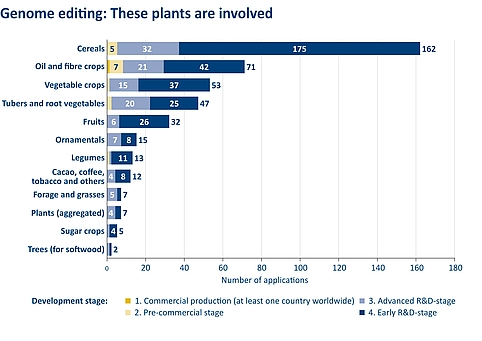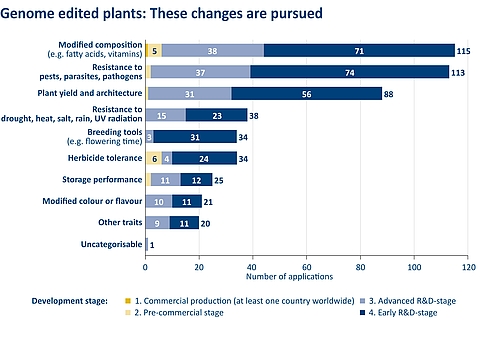Topic in Focus
The Potential of Green Genetic Engineering

Photo: Adobe Stock / lovelyday12
For thousands of years, people have striven to select crops for higher yields, resistance to pests, larger fruits or better taste. Modern molecular genetic techniques accelerate these breeding processes and broaden the spectrum. They can contribute to a more climate and environmentally friendly agriculture as well as secure and improve human nutrition.
The 21st century poses significant challenges for humankind. Global warming is advancing and changing the conditions for crop cultivation in many places. Farmers have to expect more frequent periods of heat, droughts, floods or pest infestations. At the same time, the world’s population is growing and with it grows the demand for food. The United Nations (UN) expects the world’s population to rise from its current total of almost 7.9 billion to 9.7 billion by 2050.
With the UN’s “Agenda 2030,” the global community has set itself goals for socially, economically and ecologically sustainable development. As a consequence, agriculture must also be transformed. The way it is currently practiced in many countries is detrimental to nature and ecosystems. It contributes to biodiversity loss, relies on abundant water, fertilizers and pesticides, and leaves depleted soils in its wake.
“Genome editing techniques certainly have great potential to contribute to the fight against famine. But not as a universal remedy. Hunger is a very complex issue with multiple causes. Nevertheless, technology can make a concrete contribution because we live on a planet with very limited and scarce resources, and the demand for food continues to grow. So we will have to produce more but without having more land, water and other resources. Moreover, we will have to produce in a more climate-sensitive way. Technologies must be developed that make plants more adaptable to climatic conditions. And if we can actually use these new tools to precisely enhance and amplify exactly these kinds of traits in plants, then we have a potential that is important for combating famine.”
“Food production should become more sustainable,” states the explanatory notes to the UN’s 17 Sustainable Development Goals. Green genetic engineering methods are not explicitly mentioned in this context. From a scientific perspective, however, it is clear that genome editing in plants can be used as one of several tools to address pressing global challenges. For example, it opens up a comparatively fast and straightforward way to better adapt crops to new conditions arising from global warming.
Global challenges: Tolerance to climate stress
Research is being conducted worldwide to improve the stress resilience of plants through genome editing. This is shown in a report published at the end of April 2021 by the Joint Research Centre (JRC) of the Commission of the European Union (EU) on current and future market applications of new genomic techniques (NGTs). The report provides an overview of already approved genome edited products and projects in the early stages of research and development.
According to the JRC report, 120 of the 426 applications in plants are aimed to modify crops in a way that makes them less susceptible to diseases caused by fungi, viruses and other pathogens. This is of particular interest in view of climate change, because the associated accumulation of extreme weather conditions puts plants under greater stress and makes them more susceptible to disease. In addition, crops that are per se less susceptible to disease require no or fewer pesticides and thus contribute to environmentally friendly agriculture. Last but not least, such breeding stabilises or increases yields – which is significant with respect to the growing world population.
“The new genome editing methods such as CRISPR/Cas are an important advancement of previous breeding methods. They open up many new possibilities and offer the chance to achieve desirable crop traits more quickly, such as disease resistance. But I think other methods will continue to be important like hybrid breeding, which was introduced decades ago, marker technology, or methods based on a deeper understanding of the crop genomes. In that respect, I would not call genome editing an utterly new era or revolution but simply an important advancement of the toolbox we have at hand for plant breeding.”
Photo: University Hohenheim / Jan Winkler
There are several examples where plants have already been made resistant to disease-causing viruses, bacteria or fungi with the help of the CRISPR/Cas genetic scissors. These include tomatoes resisting the powdery mildew fungus, cucumbers withstanding the yellowing virus CABYV and potatoes unaffected by potato blight. In addition, similar projects exist with cacao, rape, maize, banana, wine and wheat.
“Drought stress is a problem. We have more and more dry periods in the global south. Obviously, this is also a serious problem in tropical regions. If the plants, such as rice, were better adapted to this, it would be possible to achieve higher yields even under the conditions of climate change. Irrigation is used in many regions, where soil salinisation is also a problem. Of course, this has to be controlled through proper irrigation management. But if we have varieties that are more salt-tolerant, we can achieve higher yields even under these conditions. Another problem that is increasing due to climate change is pests. If we succeed in breeding resistant varieties, then we will consequently have better yields under those conditions. Or we can reduce the use of chemical pesticides.”
“The idea of developing plants with deeper roots that still produce high yields is also interesting. Plants with deeper roots get better access to water and nutrients in the soil and do not need as much fertiliser and irrigation. In addition, the root mass binds CO2. Since it is not harvested but will remain in the ground, more CO2 is stored in the soil, thus counteracting climate change.”
In 40 of the 426 projects surveyed by the JRC, researchers are working to improve plants’ resistance to so-called abiotic stressors. These are primarily environmental factors that make field cultivation difficult: Drought, heat, floods, ultraviolet radiation or elevated salt concentration in the soil. It is to be expected that these factors will play an increasingly important role in connection with global warming and pose new problems for agriculture in many places. Against this background, green genetic engineering can contribute significantly to the agriculture of the future.
Sustainable food for Europe
The declared goal of the European Green Deal is to transform Europe into a climate-neutral continent by 2050. To achieve this, the first step is to reduce net greenhouse gas emissions by at least 55 per cent by 2030 compared to the levels of 1990. An integral part of the project concerns the agricultural and food sector, which is to become more climate and environmentally friendly within the framework of the “Farm to Fork” strategy. This also involves preparing the agricultural sector for the foreseeable consequences of global warming.
“From a consumers’ point of view, the prospect of using fewer chemical pesticides is positive. Biodiversity protection is important to the citizens. The new genome editing methods certainly have the potential to achieve this goal more quickly than conventional methods. From my point of view, it is, of course, important that consumers have the freedom of choice. But this can be achieved through appropriate labelling.“
The agricultural sector is responsible for a significant share of global greenhouse gas emissions. According to the German Federal Environment Agency, agriculture in Germany contributed 8.2 per cent of the country’s total greenhouse gas emissions in 2020 – slightly more than industry (7.9 per cent). This calculation does not yet include greenhouse gas emissions from land use change, such as draining peatlands or deforestation for agricultural use. Methane, which is released during digestion processes in animal husbandry, or nitrous oxide, which is released during fertilisation, are typical examples of greenhouse gases caused by agriculture. The agricultural sector’s share of greenhouse gas emissions is similarly high throughout the rest of Europe, bringing the EU average to 8.7 per cent. Globally, agriculture and forestry, including land use change and the entire food sector, account for about 30 per cent of man-made greenhouse gases.
The interconnectedness of agriculture and climate change underlines the need for a reorientation of the agricultural and food system. The novel processes of green genetic engineering could prove to be a helpful tool in this process, making the cultivation of crops more environment- and climate-friendly. This is also the conclusion of the European Commission’s study on new genomic techniques, published in April 2021. It highlights the potential of genome edited crops to contribute to a more resilient and sustainable agricultural and food system.
Figure 1: Number of research and development (R&D) projects worldwide in which plants receive modified or new traits via genome editing, itemised by plant species. The overview of 426 projects in total was compiled for a report by the Joint Research Centre of the European Commission. Source: Parisi, C., Rodrigeuz-Cerezo, E., Current and future market applications of new genomic techniques, Luxembourg, 2021 | Illustration: Emde Grafik
Genome editing with regard to health
Among the many possible applications of genetic scissors in plants are modifications that benefit health or have other advantages for consumers. Possible goals of genome editing in plants are to increase the content of specific vitamins, to eliminate or reduce allergenic substances or to refine the taste.
The JRC’s 2021 report shows that such developments are already underway. Of the total 426 genome editing applications in plants recorded worldwide, 121 are aimed at changing the ingredients of crops – which is often linked to creating healthier products. In 21 other applications, the aim is to change colour or taste.
The spectrum of potential new food properties is broad: in peanut plants, the genes responsible for the production of allergenic proteins can be modified. Research is also being conducted on allergen-free carrots, apples and tomatoes, as well as on coffee plants that produce caffeine-free beans. One example of a visual change is champignon mushrooms, where the cut surfaces only turn brown at a relatively late stage.
Figure 2: Number of research and development (R&D) projects worldwide in which plants are to receive modified or new traits via genome editing, itemised by trait categories. The overview of 426 projects in total was compiled for a report by the Joint Research Centre of the European Commission. Source: Parisi, C., Rodrigeuz-Cerezo, E., Current and future market applications of new genomic techniques, Luxembourg, 2021 | Illustration: Emde Grafik
More competition, more diversity
Genome editing methods are efficient and cost-saving. That promotes competition on the one hand and a broad spectrum of ideas and methodological approaches on the other. The EU Commission’s JRC report lists more than 66 plant species in its database to be given new traits using new genomic methods. These also include orphan crops such as cassava, millet and chickpeas, which have so far played only a minor role in plant breeding.
In the statement “Towards a scientifically justified, differentiated regulation of genome edited plants in the EU” (2019), the German National Academy of Sciences Leopoldina, the German Research Foundation and the Union of the German Academies of Sciences and Humanities emphasise that genome editing may also be used by small and medium-sized enterprises and public research institutions. Developing countries are offered new opportunities due to this comparatively easy-to-apply technology.
As the approval process for genetically modified organisms in the EU is expensive and takes a long time, mainly large multinational corporations have been involved up to now. A science-based regulatory practice could facilitate small and medium-sized enterprises’ access to the market for new plant varieties and seeds, the statement reads. This would help counteract the monopolisation process in the already highly concentrated international market. This process also reduces applications to a small number of crop species – primarily cash crops such as maize, cotton, and soybeans. In the future, genetic scissors could also make the breeding of previously neglected and insufficiently utilised crops as well as fruit and vegetable plants of only regional importance more economically attractive. Furthermore, the spectrum of traits that could be improved or supplemented would increase as well.
The JRC’s inventory of approaches with genome edited crops confirms this assessment. It shows that genetic scissors are already being used in developing countries. Of the 426 projects listed, 50 come from developing countries or consortia involving developing countries. Most of them are concerned with protecting plants from biotic stress – i.e., diseases caused by viruses, fungi, and other pathogens. In addition, improving the nutritional properties of food, for example, the vitamin content, is a frequent goal.
An important player in these efforts is the international agricultural research network CGIAR, where developing and industrialised countries, government institutions, civil society organisations and representatives of the private sector work in collaboration. The CGIAR is dedicated to ensuring sustainable food and nutrition security and reducing poverty in developing countries through scientific research and activities in agriculture, forestry, fishery and the environment.
To this end, the global research partnership supports 15 independently operated, non-profit research institutions – such as the International Rice Research Institute in Los Banos/Philippines or the International Maize and Wheat Improvement Center in Mexico City/Mexico. Meanwhile, eight of these centres are also using new breeding methods, especially CRISPR/Cas.
Published: October 2021




